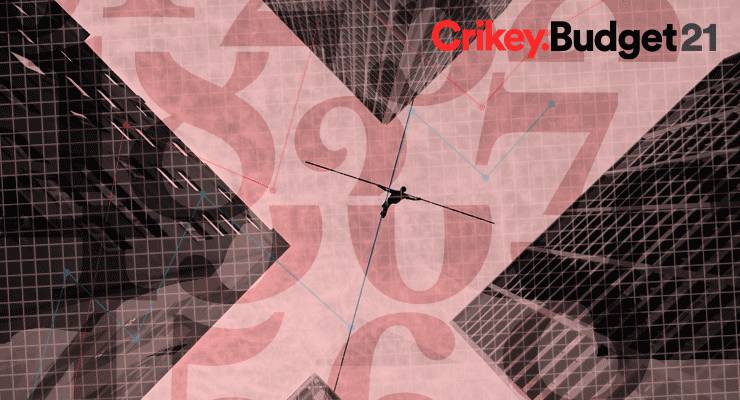
Call it the “Frydenberg pivot”. The government has shifted away from the mantra of debt and deficit toward a willingness to use fiscal policy when warranted.
No longer will the Liberal Party be — as one Liberal MP proudly told me last year — “the party of thrift”. No turns toward austerity. Rather, Frydenberg’s Liberal Party wants to be the party of economic growth.
And, with some nudging from Treasury and others, the Liberals have come to understand that economic growth is not only the best way to make all Australians better off, it’s the best way to deal with the debt incurred during the pandemic.
Since this is a fiscal strategy grounded in sound economics, rather than fearmongering and sloganeering, it is a welcome development.
But we should also hold the government accountable for delivering on the strategy.
The economics of the pivot
At a macroeconomic level there are really two key variables for the government: the interest cost of servicing government debt (r) and the growth rate of national income (g). As Chris Edmond, Bruce Preston and I wrote in an article last year, these two variables are the key to understanding debt sustainability.
If r>g, then holding the debt-to-income ratio constant requires higher taxes either now or in the future. If r=g, no changes in taxes are required in order to hold the debt-to-income ratio constant.
But if r<g, then even with holding the level of taxes fixed, the debt-to-income ratio will decline over time. In this sense, r<g means the implicit cost of servicing the stock of outstanding debt is relatively low. This means the government could cut taxes or increase spending and still keep the debt-to-income ratio constant.
With the cost of debt at historic lows, a decent rate of economic growth means that the federal government’s debt can shrink away over time.
In fact, with the government able to borrow long term — say 30 years — at around 1.5%, even a decent rate of national income growth will lead to debt shrinking relatively fast. This opens the door to the kind of spending initiatives seen in this budget, and the tax cuts that have already been legislated.
Measuring success
How will we know if the new Liberal strategy is working?
Under the old focus on debt and deficit, success was easy enough to measure and announce. If there was a sniff of a budget surplus — however questionable the assumptions underpinning it might be — the government could start handing out black coffee mugs, do cheesy video grabs, and generally declare victory.
But under the more economically sensible and nuanced Liberal budget strategy, measuring success is, well, more nuanced.
We can, of course, just look at growth in national income and the cost of debt and judge the government by the gap between the two. But that is a rather backward-facing approach, and it only focuses on the narrow question of whether government debt is sustainable.
The real question is whether it is delivering on increasing living standards for Australians. For that we need to focus on a basket of key economic statistics: GDP per capita, unemployment, and wages growth.
GDP per capita tells us a broad measure of economic growth. Before COVID it had almost ground to a halt. GDP itself was being propped-up by population growth due to immigration. We won’t see that level of immigration again for a while.
And we shouldn’t accept the government attempting to mislead us by pointing to the overall size of the economy rather than at what each Australian’s average share of it is. The latter is what drives living standards.
The unemployment rate is not only a crucial factor in determining wellbeing, it is also reflective of how business thinks the economy will perform in the near future. Hiring more people is a sign of optimism.
A lower unemployment rate than we had before COVID will be required to drive wages up. We don’t know exactly how low it needs to be to get wages growing robustly, but we do know two things: real wages in Australia have barely moved since 2013, and in the US and UK it took unemployment rates below 4% to do so.
The government’s budget forecast of 4.5% unemployment in 2023-24 is probably not low enough to really boost wages above inflation. Budget forecasts for the wage price and consumer price indices also reflect this.
Frydenberg has made a significant shift in the fiscal strategy and political branding of the Liberal Party. It is good economics, and should make for good politics — if the government can hold its nerve.
Richard Holden is professor of economics at UNSW Business School, and President-elect of the Academy of the Social Sciences in Australia.








If Prof Holden were an MMT economist, he’d critique the budget differently. The govt doesn’t need to borrow to fund public expenditure. It chooses to give wealthy people guaranteed capital returns plus interest at the public’s expense. The govt could provide a jobs guarantee on a liveable, secure wage, to put a floor under wages and reduce unemployment to near zero, lifting people out of dire poverty and hopelessness and without risking inflation. It could invest in the major problems facing society, creating 1000s of jobs in the public and private sectors including in targetted areas of manufacturing to add value to our abundant mineral wealth and in R&D. Hell, it could invest in the Arts and Humanities – both of which are characteristic of highly desirable cultures and the complex skillsets for strategic planning and innovation. it could tackle the existential problems of climate and environmental collapse instead of exacerbating them, starting with the simple abolition of fossil fuel subsidies. And the economy would grow, wellbeing would grow, and there’d be much less poverty and egregious growth at the top of the wealth and income scales and we’d begin to prepare ourselves for the disasters ahead (extreme weather, more pandemics, more complex international relations). If a mainstream economist can’t tell us what the right level of unemployment is for wage growth, perhaps the economics is the problem.
The problem is economists are the cheap version of actuaries. The Government and financial sectors have traded the specialists for the GP’s. That’s why the creek is a bit stinky. Wrong solutions for the problems. Snake oil salesmen have made a big comeback in our busy hopeful lives. Anyway…
But Australian Government debt is in A$ – and as MMT proponents point out the Australian government is the only authority that can issue A$. Not you, not me, not states, not territories. Only the federal government. That is why the budget of any national government issuing its own currency is NOT like your credit card. Debt per se is not the problem. Inflation is – and at the moment that is many years away. So the government can and should pump money into useful outcomes for society without the focus on debt – although I know that folks like talking about really big numbers.
Instead of trickle down tax cuts (these ones will work I promise – eye roll emoji), we could fund education, mental health, services for those in need, and then the economy would look after itself. Instead we have an economist tell us Joshy has done all the right things because some rich people will become more wealthy
Is it necessary to be a Professor of Economics to completely miss the point, or does it just help?
Scott Morrison has never had a problem spending public money – he’s been happy to spend it carelessly and without accountability when it serves his own ambition and the interests of his supporters.
This budget is not “a fiscal strategy grounded in sound economics, rather than fearmongering and sloganeering”. It is driven by Morrison’s fear of losing the next election unless he can change the narrative, particularly around his government’s failures in aged care and with women’s issues. It also serves to divert attention from his government’s performance on climate change, energy and the environment.
He is prepared to abandon his previous pretense of fiscal discipline to do so, and the pandemic provides the excuse for this “pivot”.
Whether much of this money will be spent in any constructive way by this government also is doubtful. We can be sure, based on his record, that it will not be spent for the benefit of those in need but will provide further opportunities for Liberal aligned interests to further feed at the public trough.
Injecting this amount of public money into the economy needs to be taken very seriously – assuming this government is serious or competent in this “pivot” (and has abandoned sloganeering and fearmongering) is not the starting point for that discussion…
How will we know if the new liberal strategy is working?
If it gets them re elected.